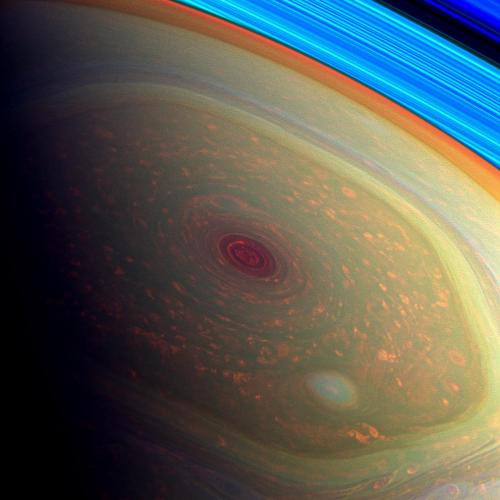Thousands Of Stars In The Orion Nebula

Thousands of Stars in the Orion Nebula
Close inspection of the 2006 Hubble Space Telescope color mosaic of the Orion Nebula (M42) reveals numerous treasures that reside within the nearby, intense star- forming region. Southwest of the Trapezium stars located in the center of the nebula, a stunning Hubble Heritage portrait captures a variety of intricate objects. Deeply contrasting areas of light and dark blend with a palette of colors mix to form rich swirls and fluid motions that would make even the best artists stand back and admire their work.
Visible slightly bottom right center is the star LL Orionis (LL Ori), originally release by the Hubble Heritage Project in 2002. The delicate bow shock that surrounds LL Ori points towards the stream of gas flowing slowly away from the center of the Orion Nebula, near the Trapezium stars located off the image to the upper left. Close examination of the ends of the bow shock show secondary shocks that are formed as a two-sided jet of gas flowing away from this forming star at high velocity strikes the stream of low velocity gas from the center. To the right of LL Ori, a ghostly veil of material hangs thick and dark, obscuring portions of the nebula behind it.
Credit: NASA/Hubble
More Posts from Night-hides-the-world and Others

“The shockwave from a 20,000 year-old supernova explosion in the constellation of Cygnus is still expanding into interstellar space. The collision of this fast moving wall of gas with a stationary cloud has heated it causing it to glow in visible as well as high energy radiation, producing the nebula known as the Cygnus Loop (NGC 6960/95). The nebula is located a mere 1,400 light-years away. The colors used here indicate emission from different kinds of atoms excited by the shock: oxygen-blue, sulfur-red, and hydrogen-green. This picture was taken with the Wide Field and Planetary Camera 2 on board the Hubble Space Telescope.”
Photo by J Hester of ASU, description via NASA.

12072022: Edge of the Carina Nebula | First Images from The James Webb Space Telescope. Photography credits: NASA, ESA, CSA, and STScI
This shows the development of imagery we have for nebulae!

Saturns Swirling Cloudscape
js


Venezuela by Jonas Piontek

The glow of ionized hydrogen in the Flame Nebula, in Orions belt, by Adam Block
js

What do you get when you combine a doctor, engineer & astronaut? Mae Carol Jemison! Dr. Jemison flew on Space Shuttle Endeavour in Sept 1992 to become the 1st African-American woman in space. The 7-day, 22-hour flight was the 50th Shuttle mission & had a focus on conducting microgravity investigations in materials & life sciences. Dr. Jemison also holds an amazing 9 doctorates; don’t know how that’s humanly possible; getting my BA was tough enough!
Nobody better slam my girl Hubble Telescope after the Webb Telescope pics came out, alright? For YEARS she was the baddest bitch around and we owe her nothing but gratitude

Lake Turkana in Northern Kenya. In the setting scene, Venus can be seen peeking over the clouds.
Credit to Babak A. Tafreshi
-
 kzhrnv liked this · 2 years ago
kzhrnv liked this · 2 years ago -
 sleepygyaal liked this · 4 years ago
sleepygyaal liked this · 4 years ago -
 morganeliseh liked this · 5 years ago
morganeliseh liked this · 5 years ago -
 loophole2000 liked this · 6 years ago
loophole2000 liked this · 6 years ago -
 coconutshipwreck liked this · 6 years ago
coconutshipwreck liked this · 6 years ago -
 iblue-kitzune liked this · 6 years ago
iblue-kitzune liked this · 6 years ago -
 artemisnightingale216 liked this · 6 years ago
artemisnightingale216 liked this · 6 years ago -
 queencfthestars liked this · 6 years ago
queencfthestars liked this · 6 years ago -
 kusta-astronaut reblogged this · 8 years ago
kusta-astronaut reblogged this · 8 years ago -
 torrent-the-witch-blog liked this · 8 years ago
torrent-the-witch-blog liked this · 8 years ago -
 alejandro161052 liked this · 8 years ago
alejandro161052 liked this · 8 years ago -
 weeping-will0w reblogged this · 8 years ago
weeping-will0w reblogged this · 8 years ago -
 kindredroots liked this · 8 years ago
kindredroots liked this · 8 years ago -
 summerbrookereding liked this · 9 years ago
summerbrookereding liked this · 9 years ago -
 donpris reblogged this · 9 years ago
donpris reblogged this · 9 years ago -
 captainnfox reblogged this · 9 years ago
captainnfox reblogged this · 9 years ago -
 720flipgrip reblogged this · 9 years ago
720flipgrip reblogged this · 9 years ago -
 delilikozgurluktur reblogged this · 9 years ago
delilikozgurluktur reblogged this · 9 years ago -
 sleepwalkerboy-blog-blog liked this · 9 years ago
sleepwalkerboy-blog-blog liked this · 9 years ago -
 uzaylimisiniz reblogged this · 9 years ago
uzaylimisiniz reblogged this · 9 years ago -
 sanadairben liked this · 9 years ago
sanadairben liked this · 9 years ago -
 pinarsahin9918-blog liked this · 9 years ago
pinarsahin9918-blog liked this · 9 years ago -
 benbozukplak reblogged this · 9 years ago
benbozukplak reblogged this · 9 years ago -
 freak--ness reblogged this · 9 years ago
freak--ness reblogged this · 9 years ago -
 uykucutirex reblogged this · 9 years ago
uykucutirex reblogged this · 9 years ago -
 musicismylife00000-blog liked this · 9 years ago
musicismylife00000-blog liked this · 9 years ago -
 xloveisalie reblogged this · 9 years ago
xloveisalie reblogged this · 9 years ago
Astronomy and the other wonders you witness when you look to the skies.
115 posts
